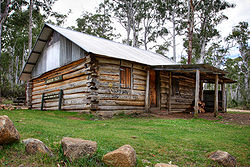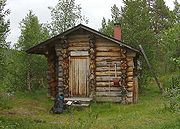
Wilderness hut
Encyclopedia


A wilderness hut is a rent-free, open dwelling place for temporary accommodation, usually located in wilderness areas, national park
National park
A national park is a reserve of natural, semi-natural, or developed land that a sovereign state declares or owns. Although individual nations designate their own national parks differently A national park is a reserve of natural, semi-natural, or developed land that a sovereign state declares or...
s and along backpacking
Backpacking (wilderness)
Backpacking combines the activities of hiking and camping for an overnight stay in backcountry wilderness...
routes. As such, the tradition is largely found in Finland
Finland
Finland , officially the Republic of Finland, is a Nordic country situated in the Fennoscandian region of Northern Europe. It is bordered by Sweden in the west, Norway in the north and Russia in the east, while Estonia lies to its south across the Gulf of Finland.Around 5.4 million people reside...
, and to some extent in Sweden
Sweden
Sweden , officially the Kingdom of Sweden , is a Nordic country on the Scandinavian Peninsula in Northern Europe. Sweden borders with Norway and Finland and is connected to Denmark by a bridge-tunnel across the Öresund....
, Norway
Norway
Norway , officially the Kingdom of Norway, is a Nordic unitary constitutional monarchy whose territory comprises the western portion of the Scandinavian Peninsula, Jan Mayen, and the Arctic archipelago of Svalbard and Bouvet Island. Norway has a total area of and a population of about 4.9 million...
, and northern Russia
Russia
Russia or , officially known as both Russia and the Russian Federation , is a country in northern Eurasia. It is a federal semi-presidential republic, comprising 83 federal subjects...
too.
The huts can be divided into official and unofficial, or maintained and unmaintained ones. Official wilderness huts are mostly maintained by Metsähallitus
Metsähallitus
Metsähallitus , Forststyrelsen , "Administration of Forests," is a state-owned enterprise in Finland. The tasks of Metsähallitus are to manage most of the protected areas of Finland and to supply wood to the country's forest industry. Metsähallitus employs approximately 3,000 people...
(Finnish
Finnish language
Finnish is the language spoken by the majority of the population in Finland Primarily for use by restaurant menus and by ethnic Finns outside Finland. It is one of the two official languages of Finland and an official minority language in Sweden. In Sweden, both standard Finnish and Meänkieli, a...
for Administration of Forests), the Finnish state-owned forest management company. Most of the wilderness huts in Finland are situated in the northern and eastern parts of the country. Their size can vary greatly: the Lahtinen cottage in the Muotkatunturi Wilderness Area
Muotkatunturi Wilderness Area
The Muotkatunturi Wilderness Area is a wilderness reserve in Lapland, Finland, established in 1991. Its area is . Muotkatunturi is a reindeer management area, and forestry is also practiced there. The area is maintained by the Metsähallitus.There are no marked paths for travelers, and the area...
can barely hold two people, whereas the Luirojärvi cottage in the Urho Kekkonen National Park
Urho Kekkonen National Park
Urho Kekkonen National Park is a national park in Lapland, Finland. Established in 1983 and covering , it is one of Finland's largest protected areas. It is named after Urho Kekkonen, former President and Prime Minister of Finland....
can hold as many as 16.
A wilderness hut need not be reserved beforehand, and they are open for everyone.
History
For centuries the vast wildernesses of Finland and its resources were divided amongst the Finnish agricultural societies (such as families, villages, parishes, and provinces) for the purpose of collecting resources. Areas owned in this way were called erämaa, literally "portion-land". People from agricultural societies made trips to their erämaas in summer, mainly to trap furFur
Fur is a synonym for hair, used more in reference to non-human animals, usually mammals; particularly those with extensives body hair coverage. The term is sometimes used to refer to the body hair of an animal as a complete coat, also known as the "pelage". Fur is also used to refer to animal...
-bearing animals but also to hunt game, fish, and collect taxes from the local hunter-fisher population.
Huts were built in the wilderness for use as base camps for hunters and fishers from agricultural societies. Also non-agricultural Sami people
Sami people
The Sami people, also spelled Sámi, or Saami, are the arctic indigenous people inhabiting Sápmi, which today encompasses parts of far northern Sweden, Norway, Finland, the Kola Peninsula of Russia, and the border area between south and middle Sweden and Norway. The Sámi are Europe’s northernmost...
built huts to help them manage reindeer. The earliest huts were meant only for the use of people from the society that owned them. People from other societies were not allowed to use the resources of other societies' erämaas.
Huts that were free for everyone were first seen in late 18th century Finland, when dwelling places were built along walking routes for passers-by. In the 19th century the authorities started building these huts. Later in the 20th century they started to be built for travellers.
Customs
Lapin läänin autiotupatoimikunta (The wilderness hut commission of Lapland Province) wrote these "unwritten laws of the wilderness" in the mid-20th century:- Anyone who steals or deliberately destroys or damages other people's property behind an unlocked door not only commits a crime but also a shameful and cowardly act. So leave the contents of the cottage in good shape when you leave. This means that, should you return to the cottage, they will be in good condition. Huts can (and will) be locked if there's ill conduct.
- When you enter the cottage, check that the fireplace is in safe and in good working order before you light a fire. If there is a problem and you cannot fix it, leave a message detailing the problem, so that the owner will know about it and can fix it.
- Use the firewood reserves of the cottage sparingly unless you can immediately obtain new billets, as the next visitor may have an urgent need of dry wood. It is obvious that whittling kindling out of bunk boards, to say nothing of burning them, is an outrageous infringement of the laws of the wilderness.
- Use the cottage's food and other emergency supplies only in a really urgent situation. Another passer-by may later perish without them.
- Keep the cottage tidy, and the surroundings and the water supply clean. Leave the trees around the cottage in peace.
- Upon leaving the cottage, clean it well and provide it with at least the same amount of firewood that you have burned. A good traveller leaves a plentiful supply of billets and, if the stocks are low, replenishes them.
- If there is a guestbook in the cottage, leave your name, the date and words about your trip. Do not carve your initials in the walls of the cottage; this is an ugly habit that should be broken.
- If you can, leave a box of matches, dry kindling, bread, salt, or other non-perishable food in the cottage, perhaps in a bag hanging from the ceiling, safe from mice.
- Before you close the door make sure that the fire in the fireplace has completely died out and that there is no danger of it restarting.
- The last person to arrive at the cottage has a greater right to use it than those already dwelling there. So, if the cottage cannot hold everyone, those who have stayed there the longest are obliged to make room for those just arriving and tired. The old Finnish saying must be remembered: Sopu sijaa antaa (Harmony gives room). Also, note the American saying: "First in, first out".
- Lastly: never rely solely on the wilderness huts while hiking, on the popular routes they may be crowded. Always carry a tentTentA tent is a shelter consisting of sheets of fabric or other material draped over or attached to a frame of poles or attached to a supporting rope. While smaller tents may be free-standing or attached to the ground, large tents are usually anchored using guy ropes tied to stakes or tent pegs...
or some cloth applicable to making a shelter.
See also
- Mountain hut - building located in the mountains intended to provide food and shelter to mountaineers and hikers
- BothyBothyA bothy is a basic shelter, usually left unlocked and available for anyone to use free of charge. It was also a term for basic accommodation, usually for gardeners or other workers on an estate. Bothies are to be found in remote, mountainous areas of Scotland, northern England, Ireland, and Wales....
- simple shelter - Laavu – lean-to, small building intended for temporary residence during hiking or fishing trips in the wilderness
- Log cabinLog cabinA log cabin is a house built from logs. It is a fairly simple type of log house. A distinction should be drawn between the traditional meanings of "log cabin" and "log house." Historically most "Log cabins" were a simple one- or 1½-story structures, somewhat impermanent, and less finished or less...
- small house built from logs - Backcountry hutBackcountry hutBackcountry huts are huts that serve overnight hiking and trekking needs and can be found in many places in the world.-New Zealand:New Zealand has a network of approximately 950 backcountry huts...
– huts that serve overnight hiking and trekking needs

